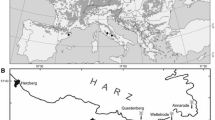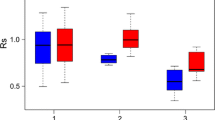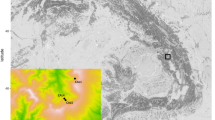Abstract
Climate extremes are expected to increase in frequency and magnitude as a consequence of global warming, threatening the functioning, services and goods of forest ecosystems. Across Europe, the ecologically and economically important tree species Fagus sylvatica is expected to suffer particularly under such conditions. The regional introduction of provenances from drier and warmer climates is one option to adapt beech forest ecosystems to these adverse effects of climate change. Marginal populations from the drought-prone southern and north-eastern edges of the species’ distribution come into focus in search of suitable candidates for Central European deciduous forests. Here, we test three marginal provenances (Spain, Bulgaria and Poland) and three provenances from the centre of the distribution range (Germany) for their response to drought in two different soil types (sand, loam) in a full factorial common garden experiment in Landau, Germany. Drought impacted all growth parameters negatively (leaf damage +22 % (percentage points), height −40 % and diameter increment −41 %), and the sandy substrate exacerbated this effect. However, provenances differed in their response to drought and soil type. Evidence for a local adaptation to summer drought was detected, especially in terms of mortality rates. The Bulgarian and Spanish provenance showed a stable performance under drought conditions (BG −27 % in diameter increment; ES −32 %), compared to the Polish (−48 %) or the most sensitive German provenances (−57 %), yet for Bulgaria on a low level of total increment. This may indicate a trade-off between drought tolerance and growth. Therefore, a sole focus on drought-resistant marginal provenances seems to not be conducive, as they might be less adapted to other climatic factors, e.g. frost, as well. However, intermixed with local Central European provenances, these may act as functional insurance in future drought-prone forest stands.






Similar content being viewed by others
References
Allen CD, Macalady AK, Chenchouni H et al (2010) A global overview of drought and heat-induced tree mortality reveals emerging climate change risks for forests. For Ecol Manag 259:660–684
Beierkuhnlein C, Thiel D, Jentsch A et al (2011) Ecotypes of European grass species respond differently to warming and extreme drought. J Ecol 99:703–713
Bertrand R, Lenoir J, Piedallu C et al (2011) Changes in plant community composition lag behind climate warming in lowland forests. Nature 479:517–520
Betsch P, Bonal D, Breda N et al (2011) Drought effects on water relations in beech: the contribution of exchangeable water reservoirs. Agric For Meteorol 151:531–543
Bolte A, Czajkowski T, Kompa T (2007) The north-eastern distribution range of European beech—a review. Forestry 80:413–429
Bolte A, Ammer C, Lof M et al (2009) Adaptive forest management in central Europe: climate change impacts, strategies and integrative concept. Scand J For Res 24:473–482
Bolte A, Hilbrig L, Grundmann B et al (2010) Climate change impacts on stand structure and competitive interactions in a southern Swedish spruce-beech forest. Eur J For Res 129:261–276
Bonn S (2000) Competition dynamics in mixed beech-oak stands and its modifications expected due to climate changes. Allg For Jgdztg 171:81–88
Brus R (2010) Growing evidence for the existence of glacial refugia of European beech (Fagus sylvatica L.) in the south-eastern Alps and north-western Dinaric Alps. Period Biol 112:239–246
Charru M, Seynave I, Morneau F et al (2010) Recent changes in forest productivity: an analysis of national forest inventory data for common beech (Fagus sylvatica L.) in north-eastern France. For Ecol Manag 260:864–874
Chen I-C, Hill JK, Ohlemueller R et al (2011) Rapid range shifts of species associated with high levels of climate warming. Science 333:1024–1026
Clark JS, Bell DM, Hersh MH et al (2011) Climate change vulnerability of forest biodiversity: climate and competition tracking of demographic rates. Global Change Biol 17:1834–1849
Comps B, Thiebaut B, Paule L et al (1990) Allozymic variability in beechwoods (Fagus sylvatica L.) over Central-Europe—spatial differentiation among and within populations. Heredity 65:407–417
Czajkowski T, Bolte A (2006) Different reaction of beech (Fagus sylvatica L.) provenances from Germany and Poland to drought. Allg For Jgdztg 177:30–40
Czajkowski T, Kuhling M, Bolte A (2005) Impact of the 2003 summer drought on growth of beech sapling natural regeneration (Fagus sylvatica L.) in north-eastern Central Europe. Allg For Jgdztg 176:133–143
Czucz B, Galhidy L, Matyas C (2011) Present and forecasted xeric climatic limits of beech and sessile oak distribution at low altitudes in Central Europe. Ann For Sci 68:99–108
Ellenberg H, Leuschner C (2010) Vegetation Mitteleuropas mit den Alpen in ökologischer, dynamischer und historischer Sicht, 6th edn. Ulmer, Stuttgart
Fotelli MN, Gessler A, Peuke AD et al (2001) Drought affects the competitive interactions between Fagus sylvatica seedlings and an early successional species, Rubus fruticosus: responses of growth, water status and delta C-13 composition. New Phytol 151:427–435
Fotelli MN, Nahm M, Radoglou K et al (2009) Seasonal and interannual ecophysiological responses of beech (Fagus sylvatica) at its south-eastern distribution limit in Europe. For Ecol Manag 257:1157–1164
Friedrichs DA, Trouet V, Buentgen U et al (2009) Species-specific climate sensitivity of tree growth in Central-West Germany. Trees Struct Funct 23:729–739
Gaertner S, Reif A, Xystrakis F et al (2008) The drought tolerance limit of Fagus sylvatica forest on limestone in southwestern Germany. J Veg Sci 19:757–768
Gessler A, Keitel C, Kreuzwieser J et al (2007) Potential risks for European beech (Fagus sylvatica L.) in a changing climate. Trees 21:1–11
Giannini R, von Wühlisch G (2009) Workshop COST E52 “Evaluation of beech genetic resources for sustainable forestry”. iForest Biogeosci For 3:104
Herbette S, Wortemann R, Awad H et al (2010) Insights into xylem vulnerability to cavitation in Fagus sylvatica L.: phenotypic and environmental sources of variability. Tree Physiol 30:1448–1455
Hijmans RJ, Cameron SE, Parra JL, Jones PG, Jarvis A (2005) Very high resolution interpolated climate surfaces for global land areas. Int J Clim 25:1965–1978
Hlasny T, Barcza Z, Fabrika M et al (2011) Climate change impacts on growth and carbon balance of forests in Central Europe. Clim Res 47:219–236
Hunt R (1975) Further observations on root–shoot equilibria in perennial Ryegrass (Lolium perenne L.). Ann Bot 39:745–755
IPCC (2012) Managing the risks of extreme events and disasters to advance climate change adaptation. In: Field CB, Barros V, Stocker TF, Quin D, Dokken DJ, Ebi KL, Mastrandrea M, Mach K, Plattner G-K, Allen S, Tignor M, Midgley P (eds) A special report of working groups I and II of the intergovernmental panel on climate change. Cambridge University Press, Cambridge, UK, pp 1–19
Jezik M, Blazenec M, Strelcova K et al (2011) The impact of the 2003–2008 weather variability on intra-annual stem diameter changes of beech trees at a submontane site in central Slovakia. Dendrochronologia 29:227–235
Jump AS, Hunt JM, Penuelas J (2006) Rapid climate change-related growth decline at the southern range edge of Fagus sylvatica. Global Change Biol 12:2163–2174
Jung T (2009) Beech decline in Central Europe driven by the interaction between Phytophthora infections and climatic extremes. For Pathol 39:73–94
Kawecki TJ (2008) Adaptation to marginal habitats. Annl Rev Ecol Evol Syst 39:321–342
Kölling C (2007) Klimahüllen für 27 Waldbaumarten. AFZ Der Wald 23:1242–1245
Kondoh S, Yahata H, Nakashizuka T, Kondoh M (2006) Interspecific variation in vessel size, growth and drought tolerance of broad-leaved trees in semi-arid regions of Kenya. Tree Physiol 26:899–904
Konnert M (1995) Investigations on the genetic variation of beech (Fagus sylvatica L) in Bavaria. Silvae Genet 44:346–351
Kreuzwieser J, Gessler A (2010) Global climate change and tree nutrition: influence of water availability. Tree Physiol 30:1221–1234
Kreyling J, Bittner T, Jaeschke A et al (2011) Assisted colonization: a question of focal units and recipient localities. Restor Ecol 19:433–440
Kreyling J, Thiel D, Nagy L et al (2012) Late frost sensitivity of juvenile Fagus sylvatica L. differs between southern Germany and Bulgaria and depends on preceding air temperature. Eur J For Res 131:717–725
Lebourgeois F, Breda N, Ulrich E et al (2005) Climate-tree-growth relationships of European beech (Fagus sylvatica L.) in the French Permanent Plot Network (RENECOFOR). Trees Struct Funct 19:385–401
Leuzinger S, Zotz G, Asshoff R et al (2005) Responses of deciduous forest trees to severe drought in Central Europe. Tree Physiol 25:641–650
Lindner M, Maroschek M, Netherer S et al (2010) Climate change impacts, adaptive capacity, and vulnerability of European forest ecosystems. For Ecol Manag 259:698–709
Lof M, Bolte A, Welander NT (2005) Interacting effects of irradiance and water stress on dry weight and biomass partitioning in Fagus sylvatica seedlings. Scand J For Res 20:322–328
Magri D (2008) Patterns of post-glacial spread and the extent of glacial refugia of European beech (Fagus sylvatica). J Biogeogr 35:450–463
Magri D, Vendramin GG, Comps B et al (2006) A new scenario for the Quaternary history of European beech populations: palaeobotanical evidence and genetic consequences. New Phytol 171:199–221
Matyas C, Bozic G, Goemoery D et al (2009) Juvenile growth response of European beech (Fagus sylvatica L.) to sudden change of climatic environment in SE European trials. iForest 2:213–220
Messaoud Y, Chen HY (2011) The influence of recent climate change on tree height growth differs with species and spatial environment. PLoS ONE 6:e14691
Nielsen CN, Jorgensen FV (2003) Phenology and diameter increment in seedlings of European beech (Fagus sylvatica L.) as affected by different soil water contents: variation between and within provenances. For Ecol Manag 174:233–249
Ohlemuller R, Gritti ES, Sykes MT et al (2006) Quantifying components of risk for European woody species under climate change. Global Change Biol 12:1788–1799
Penuelas J, Hunt JM, Ogaya R et al (2008) Twentieth century changes of tree-ring delta(13)C at the southern range-edge of Fagus sylvatica: increasing water-use efficiency does not avoid the growth decline induced by warming at low altitudes. Global Change Biol 14:1076–1088
Petritan AM, von Luepke B, Petritan IC (2007) Effects of shade on growth and mortality of maple (Acer pseudoplatanus), ash (Fraxinus excelsior) and beech (Fagus sylvatica) saplings. Forestry 80:397–412
Peuke AD, Gessler A, Rennenberg H (2006) The effect of drought on C and N stable isotopes in different fractions of leaves, stems and roots of sensitive and tolerant beech ecotypes. Plant Cell Environ 29:823–835
Piovesan G, Biondi F, Di Filippo A et al (2008) Drought-driven growth reduction in old beech (Fagus sylvatica L.) forests of the central Apennines, Italy. Global Change Biol 14:1265–1281
Pollastrini M, Desotgiu R, Cascio C et al (2010) Growth and physiological responses to ozone and mild drought stress of tree species with different ecological requirements. Trees Struct Funct 24:695–704
Polley H, Hennig P, Kroiher F (2009) Eine Kohlenstoffinventur auf Bundeswaldinventur-Basis: baumarten, Altersstruktur und Totholz in Deutschland. AFZ-DerWald 64:1074–1075
R Development Core Team (2010) R: a language and environment for statistical computing. R foundation for statistical computing, R version 2.11.1. R foundation for statistical computing. ISBN 3-900051-07-0, URL http://www.R-project.org, Vienna, Austria
Rennenberg H, Seiler W, Matyssek R et al (2004) European beech (Fagus sylvatica L.)—a forest tree without future in the south of Central Europe? Allg For Jagdztg 175:210–224
Rennenberg H, Dannenmann M, Gessler A et al (2009) Nitrogen balance in forest soils: nutritional limitation of plants under climate change stresses. Plant Biol 11:4–23
Richter S, Kipfer T, Wohlgemuth T et al (2012) Phenotypic plasticity facilitates resistance to climate change in a highly variable environment. Oecologia 169:269–279
Rose L, Leuschner C, Koeckemann B et al (2009) Are marginal beech (Fagus sylvatica L.) provenances a source for drought tolerant ecotypes? Eur J For Res 128:335–343
Schaberg PG, DeHayes DH, Hawley GJ et al (2008) Anthropogenic alterations of genetic diversity within tree populations: implications for forest ecosystem resilience. For Ecol Manag 256:855–862
Schall P, Lödige C, Beck M et al (2012) Biomass allocation to roots and shoots is more sensitive to shade and drought in European beech than in Norway spruce seedlings. For Ecol Manag 266:246–253
Scharnweber T, Manthey M, Criegee C et al (2011) Drought matters—declining precipitation influences growth of Fagus sylvatica L. and Quercus robur L. in north-eastern Germany. For Ecol Manag 262:947–961
Scherrer D, Bader MK, Koerner C (2011) Drought-sensitivity ranking of deciduous tree species based on thermal imaging of forest canopies. Agric For Meteorol 151:1632–1640
Schraml C, Rennenberg H (2000) Sensitivity of different ecotypes of beech trees (Fagus sylvatica L.) to drought stress. Forstw Cbl 119:51–61
Shipley B, Meziane D (2002) The balanced-growth hypothesis and the allometry of leaf and root biomass allocation. Funct Ecol 16:326–331
Varelides C, Brofas G, Varelides Y (2001) Provenance variation in Pinus nigra at three sites in Northern Greece. Ann For Sci 58:893–900
von Wuehlisch G, Krusche D, Muhs HJ (1995) Variation in temperature sum requirement for flushing of beech provenances. Silvae Genet 44:343–346
Vornam B, Decarli N, Gailing O (2004) Spatial distribution of genetic variation in a natural beech stand (Fagus sylvatica L.) based on microsatellite markers. Conserv Genet 5:561–570
Wang T, Hamann A, Spittlehouse DL et al (2006) Development of scale-free climate data for Western Canada for use in resource management. Int J Climat 26:383–397
Weitner A, Dupouey JL, Lefevre Y et al (2007) Roles of soil chemistry and water availability in site-related delta C-13 variations in French beech forests. Tree Physiol 27:1043–1051
Wortemann R, Herbette S, Barigah TS et al (2011) Genotypic variability and phenotypic plasticity of cavitation resistance in Fagus sylvatica L. across Europe. Tree Physiol 31:1175–1182
Acknowledgments
This study was funded by the “Bavarian Climate Programme 2020” in the joint research centre “FORKAST” and the Bavarian State Ministry of the Environment and Public Health (ZKL01Abt7_18456) together with the University of Koblenz/Landau. We thank the Julius-Kühn—Institute in Siebeldingen for the provision of the site and infrastructure for the experiment. Furthermore, we thank Dr. Dorota Dobrowolska, Forest Research Institute, Poland, for providing the seed material for the Polish provenance.
Author information
Authors and Affiliations
Corresponding author
Additional information
Communicated by C. Ammer.
Rights and permissions
About this article
Cite this article
Thiel, D., Kreyling, J., Backhaus, S. et al. Different reactions of central and marginal provenances of Fagus sylvatica to experimental drought. Eur J Forest Res 133, 247–260 (2014). https://doi.org/10.1007/s10342-013-0750-x
Received:
Revised:
Accepted:
Published:
Issue Date:
DOI: https://doi.org/10.1007/s10342-013-0750-x




